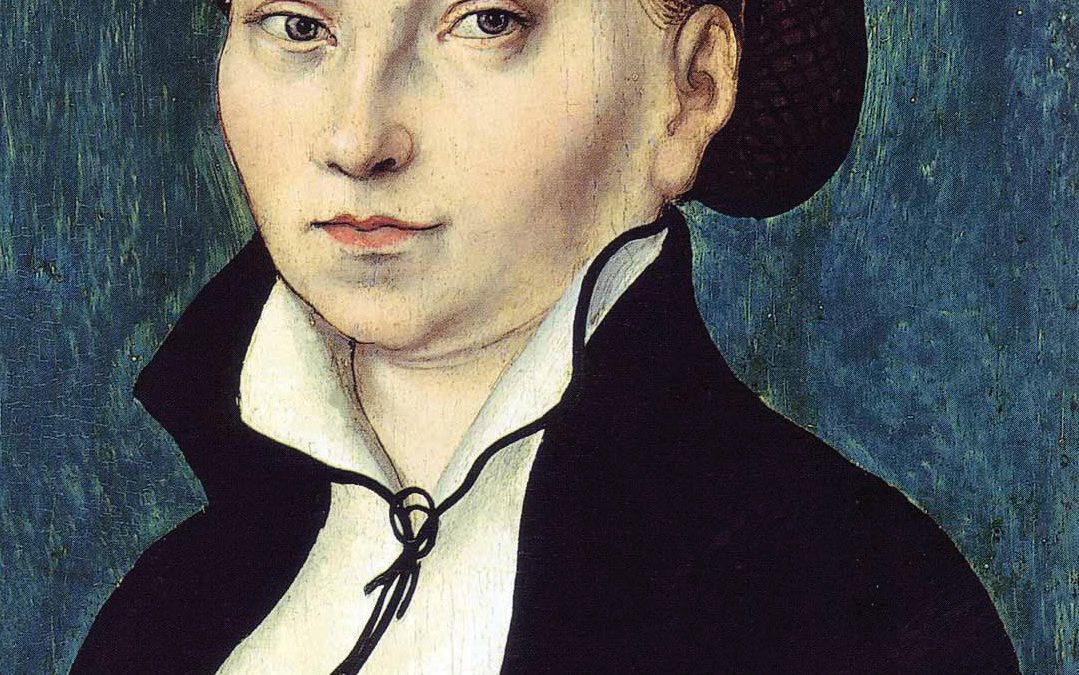by Mary Helene Rasmussen Jackson—
During my years researching the Reformation, I quickly learned that most people know three things about the event: Martin Luther had something to do with it; he pounded the 95 Theses (whatever they are!) on a church door; he married a nun.
There is much more to the story. The Reformation began 100 years before 1517. The 95 Theses were complaints about church teachings, meant for academic discussion. And, yes, he married a former nun—Katharina von Bora, an extraordinary woman who stood in strength by his side.
How can we honor Katharina, who was born on January 29, 1499? We can only try to recover her life from a century in which most women could not read, had limited legal rights, faced death from pregnancy, buried half their children and disappeared into the shadows of history. But here are 15 facts related to this incredible woman about which most scholars agree:
ONE
The von Bora family was of noble lineage but lost its fortune and lived in near poverty. Katharina’s mother died of an unknown disease. Her father remarried Margaret von Ende.
TWO
At the age of 9, she entered Nimbschen Convent near Grimma, in Germany’s Mulde Valley. Because her father could not afford a dowry, future marriage was impossible; she could become a nun or face spinsterhood, a disgrace at that time.
THREE
Katharina took her final vows of silence, poverty and charity at age 16. These promises were irreversible upon penalty of excommunication, shame and eternal separation from God and the Holy Mother Church.
FOUR
We do not know her reason for leaving the convent. We do know that six years after the firestorm of the 95 Theses, she and others secretly left in 1523. They may have been aware of the peasants’ march for religious freedom by limited contact with a nearby Augustinian monastery where some of them had brothers. Luther had visited that monastery.
FIVE
After their rocky trip to Wittenberg, Luther found jobs and sometimes husbands for the young women. Katharina learned household duties in the upscale Reichenbach and Cranach homes. She met and almost married a student, Hieronymous Baumgaertner, from Nuremberg. His parents refused permission and arranged a “suitable” marriage for him with a 14-year-old. Marriage with a former nun was a crime.
SIX
Luther offered a solution: Dr. Glatz, his old colleague, known as the Miser of Wittenberg, was willing to marry her. Katharina said, “No!” Perhaps Martin then knew he had met his match in stubbornness.
SEVEN
He proposed; she accepted. He said, “Who read in the stars that I would cause my father so much trouble and get into an argument with the Pope and take a runaway nun as my wife? Somehow, while I was doing other things, Katharina was given to me!”
EIGHT
They were married on the steps of the church. Weddings within a church did not occur until later. Following the ceremony, there was a promenade, meal and dancing at the Black Cloister, their new home. It had been a monastery, housing 40 monks, and had not been cleaned in years.
NINE
Katharina rose at 4:30 a.m. to clean the musty place, cook for family (Luther’s favorite dish was a stew of sardines, mustard and peas) and students (who lived with them), brew beer (“She makes the best beer in Germany!” Martin once said), tend vegetable gardens and rear children. Hence her husband’s name for her: “Morning Star of Wittenberg.”
TEN
Many wedding gifts were goblets to be put away and sold when money was scarce. She became the treasurer of the family and hid them when Luther gave many away to needy folks.
ELEVEN
The Luthers had six children: Hans (Johannes), Elisabeth, Magdalena, Martin, Paul and Margarethe. At Hans’ birth, Martin wrote, “My dear Kethe brought into the world a little son…I must stop. Sick Kethe calls me.” Baby Elisabeth, born during the plague when Katharina tended the sick and dying, did not live long. Their dear teenage daughter, Lena, died of a lingering illness. Luther wrote, “My Kethe is sobbing with eyes red with weeping.” Knowledge of medicine was unknown. Nobody could help. Superstition reigned over and controlled life and death.
TWELVE
In the cold winter of 1546, Katharina begged an ailing Martin not to travel to Eisleben. He went anyway. She worried; he wrote: “To the holy worrisome Lady Katharina…my heartily beloved housewife…Pray for us and let God worry.” He died a week later.
THIRTEEN
His will challenged Saxon law where a widow was given only a cane, a chair and a coat. Children and property became wards of the state. He willed both to her. His will survived. That document and Katharina’s determination in the legal fight that ensued, helped give widows their first rights.
FOURTEEN After his death, she wrote: “…I cannot tell the sorrow of my heart…I hardly know what to think or feel. I cannot eat or drink nor can I sleep…The Lord God has taken from me, and not from me only, but from the whole world, this dear and precious man. Herewith goodbye. Katharina, Martinus Luther’s relict.”
FIFTEEN She died six years later while escaping danger in Wittenberg from injuries when her wagon overturned.
Mary Helene Rasmussen Jackson is the author of Daughter of the Reformation, A Historical Perspective of the Life and Times of the Wife of Martin Luther.
This article is from the January/February 2018 issue of Gather magazine. To read more like it, subscribe to Gather.



I am reading the book, Loving Luther by Allison Pittman. It is a fiction/historical story of Katharina. Excellent writing and interpretation of the life of Katharina. No one knows all the facts, but this book is very close to other recordings. Enjoy
My mind and heart both jumped inside of me when I read that Katie signed a vow, a forever signature, to stay with her Order. She came into the convent at 9, signed this contract or vow at 15, and life goes on. Not in my book or my faith. We have a loving God and we are his loving children. When Katie left the convent, sneaking out in a truck used for fish delivery, her life began. She was not attuned to what the Catholic church was doing to raise money by making all people, rich or poor, pay for the forgiveness of sins. God does not want that to happen and he does not require large, ornate buildings to praise his name. I think outside under some trees makes a fine place for the faithful to meet in His name. I married at 20 and I loved him so much knowing I would never get a divorce. Life happened, he erred, I asked for a divorce. Was the first in my family to go to college and to get a divorce. Both served me well. I did not marry again, I certainly made my way up the rungs of the ladder of careers. Just like Katie, there was always deep love for God my entire life, worked hard. provided service to family, church and friends. God gave us our freedom, we all need to use this freedom to find our way and who we really are while we know God is with us during each and every step.